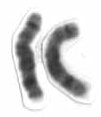8p23.1 duplication syndrome
| 8p23.1 duplication syndrome | |
|---|---|

| |
| Synonyms | |
| Pronounce | |
| Specialty | Medical genetics |
| Symptoms | Developmental delay, congenital heart defects, intellectual disability, autism spectrum disorder |
| Complications | N/A |
| Onset | Congenital |
| Duration | Lifelong |
| Types | |
| Causes | Genetic mutation |
| Risks | |
| Diagnosis | Genetic testing, karyotype |
| Differential diagnosis | 8p23.1 deletion syndrome, other chromosomal abnormalities |
| Prevention | |
| Treatment | Symptomatic and supportive |
| Medication | |
| Prognosis | Variable |
| Frequency | Rare |
| Deaths | |
8p23.1 Duplication Syndrome is a rare genetic disorder caused by the duplication of a segment of chromosome 8 at the p23.1 region. This duplication can lead to a variety of developmental and physical abnormalities.
Genetics[edit | edit source]
8p23.1 Duplication Syndrome is characterized by the presence of an extra copy of a segment of the short arm of chromosome 8. This duplication can vary in size but typically involves the region designated as 8p23.1. The duplication can occur as a de novo event or be inherited from a parent who carries a balanced translocation or inversion.
Clinical Features[edit | edit source]
Individuals with 8p23.1 Duplication Syndrome may present with a range of clinical features, including:
- Developmental delay
- Intellectual disability
- Congenital heart defects
- Distinctive facial features
- Behavioral problems
The severity of symptoms can vary widely among affected individuals.
Diagnosis[edit | edit source]
Diagnosis of 8p23.1 Duplication Syndrome is typically made through genetic testing, such as chromosomal microarray analysis or fluorescence in situ hybridization (FISH). These tests can identify the presence of the duplication and help determine its size and exact location.
Management[edit | edit source]
Management of 8p23.1 Duplication Syndrome is symptomatic and supportive. It may involve:
- Early intervention programs for developmental delays
- Special education services
- Medical management of congenital heart defects
- Behavioral therapy
Prognosis[edit | edit source]
The prognosis for individuals with 8p23.1 Duplication Syndrome varies depending on the severity of symptoms and the presence of associated medical conditions. With appropriate interventions, many individuals can lead fulfilling lives.
Related pages[edit | edit source]
Search WikiMD
Ad.Tired of being Overweight? Try W8MD's physician weight loss program.
Semaglutide (Ozempic / Wegovy and Tirzepatide (Mounjaro / Zepbound) available.
Advertise on WikiMD
|
WikiMD's Wellness Encyclopedia |
| Let Food Be Thy Medicine Medicine Thy Food - Hippocrates |
Translate this page: - East Asian
中文,
日本,
한국어,
South Asian
हिन्दी,
தமிழ்,
తెలుగు,
Urdu,
ಕನ್ನಡ,
Southeast Asian
Indonesian,
Vietnamese,
Thai,
မြန်မာဘာသာ,
বাংলা
European
español,
Deutsch,
français,
Greek,
português do Brasil,
polski,
română,
русский,
Nederlands,
norsk,
svenska,
suomi,
Italian
Middle Eastern & African
عربى,
Turkish,
Persian,
Hebrew,
Afrikaans,
isiZulu,
Kiswahili,
Other
Bulgarian,
Hungarian,
Czech,
Swedish,
മലയാളം,
मराठी,
ਪੰਜਾਬੀ,
ગુજરાતી,
Portuguese,
Ukrainian
Medical Disclaimer: WikiMD is not a substitute for professional medical advice. The information on WikiMD is provided as an information resource only, may be incorrect, outdated or misleading, and is not to be used or relied on for any diagnostic or treatment purposes. Please consult your health care provider before making any healthcare decisions or for guidance about a specific medical condition. WikiMD expressly disclaims responsibility, and shall have no liability, for any damages, loss, injury, or liability whatsoever suffered as a result of your reliance on the information contained in this site. By visiting this site you agree to the foregoing terms and conditions, which may from time to time be changed or supplemented by WikiMD. If you do not agree to the foregoing terms and conditions, you should not enter or use this site. See full disclaimer.
Credits:Most images are courtesy of Wikimedia commons, and templates, categories Wikipedia, licensed under CC BY SA or similar.
Contributors: Prab R. Tumpati, MD
